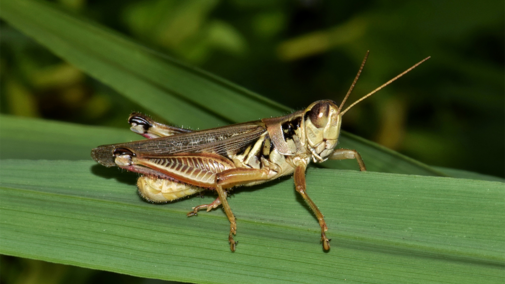Pasture Grasshopper Management
A survey of last year’s adult grasshopper populations and below-average rainfall amounts are leading to economic levels of grasshoppers in some pastures. Areas most at risk are southwest, south-central and western Nebraska, so producers in these areas are encouraged to scout their fields and pastures and select proper treatment protocols when needed.
One of the best ways to scout for grasshoppers is to use the square foot method. Randomly select an area several feet away and visualize a one square-foot area around that spot. Walk toward this spot and count the number of grasshoppers you see in or jumping out of this area. Repeat this procedure 18 times and divide the total number of grasshoppers by two. This will give you the number of grasshoppers per square yard. Economic thresholds for grasshoppers range from eight to 40 grasshoppers per square yard, depending on a variety of factors. Keep in mind that control is easiest before grasshoppers reach the adult stage.
Grasshoppers may be controlled by applying insecticides as sprays or baits using the Reduced Agent Area Treatment method. The two insecticides that can be used with this method are Dimilin 2L and Prevathon. Rates for these products are listed on the labels. Both insecticides should be applied when most of the grasshoppers average ¾ of an inch in length; therefore, it’s critical that producers scout their pastures now, as there is a short window when the insecticides are most effective.
For other grasshopper management options or questions regarding economic thresholds, please contact your local Nebraska Extension office.
Poison Hemlock
Have you noticed tall weeds with umbrella-like white flowers in pastures, ditchbanks and along the roadsides? It may be poison hemlock, a toxic plant to both people and livestock.
Poison hemlock is one of Nebraska’s top 10 poisonous plants. It thrives in wet or moist soils along streams, roadsides and pastures. Hemlock has distinctive fern-like leaves and purple spots on its stems. A biennial plant, it grows as a rosette in its first year and produces a stalk with white flowers in the second.
So, how can you manage this weed? Avoid overgrazing pastures containing hemlock. When there's plenty of forage, animals will eat the healthy, palatable plants and avoid hemlock. However, if grass gets short, even unpalatable poisonous plants might be consumed. This includes turning hungry animals into fresh pastures with hemlock; desperate animals may eat the first green plant they encounter. Ensure plenty of water, salt and minerals are always available. Animals deprived of these essentials may eat abnormally, increasing the risk of consuming hemlock. Just five pounds of foliage can be lethal for cows, and only two pounds can be deadly for horses.
Fortunately, hemlock is usually not palatable to most livestock. They won’t eat much unless it's the only green plant around or if the plant has been altered. Do not attempt to control hemlock during the grazing season by mowing or spraying. This can increase its palatability, making it more likely for animals to consume enough to be poisoned. Instead, control poison hemlock in early spring or fall when animals are not in the pasture, or fence off large patches if necessary. Options for herbicide control may include 2,4-D + Dicamba; Graslan L®; Chaparral®; Cimarron Plus®; DuraCor®; Escort XP®; and Streamline®.
Controlling Yucca on Rangeland
Yucca plants, which are also called soapweed, can be quite common on rangeland in western and central Nebraska. They are especially noticeable here in June when flowering. In some areas, they can be quite thick and significantly reduce grass production. There are ways, though, to reclaim those grazinglands.
Once established, yucca plants can increase on drier rangeland sites. They produce a deep taproot that competes aggressively for the limited water in these soils. With sharp leaves protecting the plant, cattle rarely eat it during summer. Grass production decreases while yucca thrives.
Herbicides like Remedy Ultra®; PastureGard HL®; Pathfinder II®, Tordon®, Velpar, or Cimarron Plus® can control yucca, but only when each individual plant is sprayed directly. Hexazinone products like Velpar L®; Pronone Power Pellet, or Velossa® be applied to the soil uphill side of individual yucca plants with exact delivery hand-gun applicator, since pasture grass streaking injury downslope can occur with chemical movement. General broadcast spraying to control yucca on rangeland is cost prohibitive, although small patches can and should be controlled before they expand. Herbicides are most effective when applied in spring or summer. When using herbicides, be sure to follow label directions for the best control.
Some people have had some success in reducing yucca through winter grazing. During winter, yucca often is the only green plant around. Sometimes cows actually will get down on their knees, lay their head sideways on the ground, and chew through the base of the plant to get to the moist, tender parts. It has been observed though, that it can take some time for animals to learn to graze yucca and there may be some animals in the herd that will not graze it, while others can be quite proficient. After several consecutive winters of grazing, yucca stands can be reduced so grass again thrives during summer.
Whether it is with herbicides or trying some winter grazing, this might be a good year to reclaim some of your pasture back from yucca.

